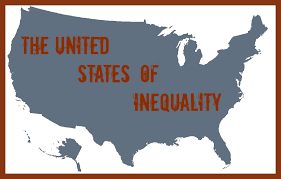The levels of wealth inequality are unprecedented and alarming
Global Research,

All Global Research articles can be read in 51 languages by activating the Translate Website button below the author’s name (desktop version)
To receive Global Research’s Daily Newsletter (selected articles), click here.
Follow us on Instagram and Twitter and subscribe to our Telegram Channel. Feel free to repost and share widely Global Research articles.
***
The levels of wealth inequality we are currently witnessing in this country are unprecedented and alarming. The very richest among us have succeeded in grabbing ever more of the proverbial pie, and the trend is only worsening. Wealth inequality is proving disastrous for America. On both collective and individual levels, we are suffering because of the ever-growing concentration of wealth in the hands of a tiny few. What is to be done? As we explain below, raise taxes on the topmost bracket of earners, and begin realizing the potential and promise of worker self-management, which has historically proven itself to be the indispensable foundation of genuine equality.
According to the Council on Foreign Relations,
“Income and wealth inequality is higher in the United States than almost any other developed country, and it is rising.” In September 2022 the Congressional Budget Office (CBO) released a report entitled Trends in the Distribution of Family Wealth, 1989-2019. The CBO found that the “growth of real wealth over the past three decades was not uniform… In 2019, families in the top 10 percent of the distribution held 72 percent of total wealth, and families in the top 1 percent of the distribution held more than one-third; families in the bottom half of the distribution held only 2 percent of total wealth.”
In fact, families in the top 1 percent saw their share of the total wealth increase by at least 7.4 percentage points – from 26.6 percent in 1989 to 34.0 percent in 2019.
Since 1989 income gains have been heavily skewed toward the topmost bracket of high earners. This is strikingly evident in the growth of CEO compensation since 1965, when “a typical corporate CEO earned about twenty times that earned by a typical worker; by 2018, the ratio was 278:1.” As the Economic Policy Institute points out, from 1978 to 2018, CEO compensation grew by over 940 percent. Wages for the typical worker on the other hand grew by less than 12 percent. CEOs are getting paid exorbitantly because of their power to set pay, “not because they are increasing productivity or possess specific, high-demand skills,” according to the EPI.
This obscene source of inequality cannot even pretend to have any legitimate economic justification: it represents unchecked greed and self-aggrandizement at the expense of everyone else—especially ordinary workers. We could learn something from Spain’s Mondragon Corporation, undoubtedly the world’s largest and most successful cooperative enterprise. Mondragon employs over 80,000 workers across nearly one hundred businesses, but no manager or executive within the company can make over six times the pay than any worker. The excessive compensation of CEOs is only one contributing factor to the rise of wealth inequality in the United States, but it is a significant factor and one that “we could safely do away with.”
Skewed: Income Inequality in America. The American Dream has Gone…
The intensifying concentration of wealth, and unjustifiable level of income inequality is proving disastrous in many ways. Here are just a few of them. First, less equal societies typically have more unstable economies, and this country is no exception. “The United States experienced two major economic crises over the past century—the Great Depression starting in 1929 and the Great Recession starting in 2007. Both were preceded by a sharp increase in income and wealth inequality…” It is also well-known that societies with greater economic equality generally also enjoy longer periods of sustained growth: simply put, “longer growth spells are robustly associated with more equality in the income distribution.”
Second, there is an incontrovertible link between economic inequality and violent crime. The fact is that rates of violence are higher in more unequal societies. Why is inequality associated with an increase in criminal activity? As equalitytrust.org observes, economic inequality “may curtail opportunities for some, giving rise to a sense of hopelessness which incites fear, violence and murder.” Certainly, inequality erodes social solidarity and trust, so much so that societies with “large income differences and low levels of trust may lack the social capacity to create safe communities.”
The erosion of perceived fairness and trust also explains the inverse relationship between economic inequality and happiness: a 2011 study, Income Inequality and Happiness, found that “the negative link between income inequality and the happiness of lower-income respondents was explained not by lower household income, but by perceived unfairness and lack of trust.”
Third, the undeniable fact is that the greater the economic inequality that exists, the worse it is for general health outcomes. What is sometimes overlooked is that income inequality is bad for health outcomes across economic strata, not just for those in poverty. To be sure, poor health and poverty are closely linked; but the epidemiological research shows that high levels of economic inequality “negatively affect the health of even the affluent, mainly because… inequality reduces social cohesion, a dynamic that leads to more stress, fear, and insecurity for everyone.” People live longer in countries with lower levels of inequality, as the World Bank reports. In the United States, for example, “average life expectancy is four years shorter than in some of the most equitable countries.”
The most obvious and readily available method for addressing wealth inequality is through taxation policy, subjecting those in the topmost economic echelon to a “high and rising marginal tax rates on earnings.” In 1944 the top marginal tax rate reached 94 percent, applying to income over $200,000, roughly equivalent to $2.8 million today, adjusted for inflation. With our collective amnesia Americans often forget that the top tax rate remained above 90 percent through the 1950s and did not dip below 70 percent until 1981. At no point during the decades that saw America’s greatest economic growth did the tax on the wealthy drop below 70 percent. Today it is somewhere around 37 percent.
There is another method, no less important, for addressing inequality, but one that gets little attention because it involves a fundamental reorganization of the relations of production: namely, worker self-management, workplace democracy – or, perhaps most accurately, worker self-directed enterprises, to use the wording of economist Richard Wolff. As Wolff points out, these enterprises “divide all the labors to be performed… determine what is to be produced, how it is to be produced, and where it is to be produced” and, perhaps most crucially, “decide on the use and distribution of the resulting output or revenues.”
One essential way to appreciate a worker self-directed enterprise is to contrast it to a typical, hierarchically organized corporation where a small board of directors, selected by a tiny number of shareholders, appropriate and distribute the surplus produced by employees. (Surplus refers to the difference between the value added by workers and the value paid to workers). In a worker self-directed enterprise, the surplus-producing workers themselves make the basic decisions about production and distribution.
According to Democracy at Work Institute, worker cooperatives have grown in number by more than 30 percent since 2019. It is estimated that there are some 900-1000 worker cooperatives in the United States, comprising roughly 10,000 workers. What these non-capitalist firms have demonstrated, among other things, is first, that they can succeed and be competitive with respect to traditionally organized firms. And second, worker self-directed enterprises can serve to alleviate income inequality, as Mondragon Corporation does, for example, by establishing a minimum and maximum income level for all workers that is equitable, and reasonable. At US worker cooperatives, the “2:1 top-to-bottom pay ratio… points to the prioritization of reducing internal inequality over other compensation goals.”
Extricating ourselves from the quagmire of inequality will require a progressive taxation policy that includes closing corporate loopholes and tax havens. But taxation is not sufficient: genuine, meaningful equality demands economic democracy. Fortunately, there is ample historical evidence to show that worker self-management can be successfully implemented on a large scale. We also know that “investment funds can be generated by taxation instead of from private savings,” as the philosopher David Schweickart has observed.
Worker self-directed enterprises will not only facilitate economic equality but will also foster a participatory-democratic consciousness within the firm and society at large, and ultimately serve as an antidote to the alienation of labor under capitalism. This is because the members of democratized workplaces are arguably no longer estranged from the act of production: empowered to make decisions regarding the labor process, production is no longer an activity ‘alien’ to the worker. In conclusion, workers self-management is an essential component in the struggle against gross inequality, exploitation, and the alienation of labor, a process that truly begins with workers formulating their own rules.



